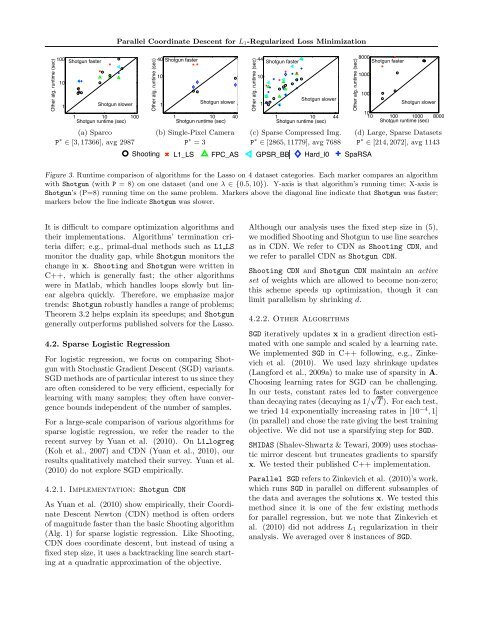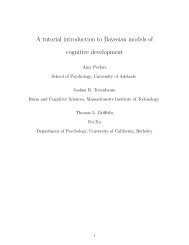Parallel Coordinate Descent for L1-Regularized Loss Minimization
Parallel Coordinate Descent for L1-Regularized Loss Minimization
Parallel Coordinate Descent for L1-Regularized Loss Minimization
Create successful ePaper yourself
Turn your PDF publications into a flip-book with our unique Google optimized e-Paper software.
<strong>Parallel</strong> <strong>Coordinate</strong> <strong>Descent</strong> <strong>for</strong> L 1-<strong>Regularized</strong> <strong>Loss</strong> <strong>Minimization</strong><br />
Other alg. runtime (sec)<br />
100<br />
Shotgun faster<br />
10<br />
Other alg. runtime (sec)<br />
40 Shotgun faster<br />
10<br />
Shotgun slower<br />
Other alg. runtime (sec)<br />
44<br />
Shotgun faster<br />
10<br />
Shotgun slower<br />
1000<br />
100<br />
10<br />
10 100 1000 8000<br />
Shotgun runtime (sec)<br />
Other alg. runtime (sec)8000<br />
Shotgun faster<br />
Shotgun slower<br />
1<br />
Shotgun slower<br />
1 2<br />
1<br />
2<br />
Shooting<br />
1 10 100<br />
1 10 40<br />
1 10 44<br />
Shotgun runtime (sec) 2 Shotgun runtime (sec)<br />
Shotgun runtime <strong>L1</strong>_LS (sec) Shooting<br />
1.8<br />
(a) Sparco 2<br />
Shooting FPC_AS <strong>L1</strong>_LS<br />
(b) Single-Pixel Camera (c) Sparse Compressed Img. (d) Large, Sparse Datasets<br />
P ∗ ∈ [3, 17366], avg 2987 P ∗ Shooting 1.8<br />
2<br />
= 3 P ∗ <strong>L1</strong>_LS GPSR_BB FPC_AS<br />
1.8<br />
∈ [2865, 11779], avg 7688 P ∗ ∈ [214, 2072], avg 1143<br />
2<br />
Shooting 1.6 <strong>L1</strong>_LS FPC_AS SpaRSA GPSR_BB<br />
1.8 Shooting <strong>L1</strong>_LS FPC_AS 1.6 GPSR_BB Hard_l0 SpaRSA<br />
1.8<br />
<strong>L1</strong>_LS 1.6 FPC_AS GPSR_BB SpaRSA<br />
Hard_l0<br />
1.8<br />
1.6<br />
FPC_AS 1.4<br />
Figure 3. Runtime comparison of algorithms GPSR_BB <strong>for</strong> theSpaRSA<br />
Lasso Hard_l0<br />
1.6<br />
GPSR_BB<br />
1.4 on 4 dataset categories. Each marker compares an algorithm<br />
with Shotgun (with P = 8) on SpaRSA Hard_l0<br />
1.4<br />
one dataset (and one λ ∈ {0.5, 10}). Y-axis is that algorithm’s running time; X-axis is<br />
1.6<br />
SpaRSA<br />
Shotgun’s (P=8) running time on the same Hard_l0 problem. 1.2 Markers above the diagonal line indicate that Shotgun was faster;<br />
1.4 Hard_l0<br />
markers 1.2<br />
1.4<br />
below the line indicate Shotgun was slower.<br />
1.4<br />
1.2<br />
1<br />
1.2<br />
1 1.2 1 1.4 1.6 1.8 2<br />
It is 1.2 difficult to compare optimization 1 1.2 1.4 1.6 1.8 2<br />
1.2<br />
1<br />
algorithms and Although our analysis uses the fixed step size in (5),<br />
their implementations. 1 1.2 1.4 1.6 1.8 2<br />
1<br />
Algorithms’ termination criteria<br />
differ; 1 e.g., primal-dual 1 1.2 methods 1.4 such 1.6 as <strong>L1</strong> 1.8 LS 2as in CDN. We refer to CDN as Shooting CDN, and<br />
we modified Shooting and Shotgun to use line searches<br />
1 monitor1 the duality 1.2 gap, 1.4 while 1.6Shotgun 1.8 monitors 2 the we refer to parallel CDN as Shotgun CDN.<br />
1 1.2 1.4 1.6 1.8 2<br />
change in x. Shooting and Shotgun were written in<br />
C++, which is generally fast; the other algorithms<br />
were in Matlab, which handles loops slowly but linear<br />
algebra quickly. There<strong>for</strong>e, we emphasize major<br />
trends: Shotgun robustly handles a range of problems;<br />
Theorem 3.2 helps explain its speedups; and Shotgun<br />
generally outper<strong>for</strong>ms published solvers <strong>for</strong> the Lasso.<br />
4.2. Sparse Logistic Regression<br />
For logistic regression, we focus on comparing Shotgun<br />
with Stochastic Gradient <strong>Descent</strong> (SGD) variants.<br />
SGD methods are of particular interest to us since they<br />
are often considered to be very efficient, especially <strong>for</strong><br />
learning with many samples; they often have convergence<br />
bounds independent of the number of samples.<br />
For a large-scale comparison of various algorithms <strong>for</strong><br />
sparse logistic regression, we refer the reader to the<br />
recent survey by Yuan et al. (2010). On <strong>L1</strong> logreg<br />
(Koh et al., 2007) and CDN (Yuan et al., 2010), our<br />
results qualitatively matched their survey. Yuan et al.<br />
(2010) do not explore SGD empirically.<br />
4.2.1. Implementation: Shotgun CDN<br />
As Yuan et al. (2010) show empirically, their <strong>Coordinate</strong><br />
<strong>Descent</strong> Newton (CDN) method is often orders<br />
of magnitude faster than the basic Shooting algorithm<br />
(Alg. 1) <strong>for</strong> sparse logistic regression. Like Shooting,<br />
CDN does coordinate descent, but instead of using a<br />
fixed step size, it uses a backtracking line search starting<br />
at a quadratic approximation of the objective.<br />
Shooting CDN and Shotgun CDN maintain an active<br />
set of weights which are allowed to become non-zero;<br />
this scheme speeds up optimization, though it can<br />
limit parallelism by shrinking d.<br />
4.2.2. Other Algorithms<br />
SGD iteratively updates x in a gradient direction estimated<br />
with one sample and scaled by a learning rate.<br />
We implemented SGD in C++ following, e.g., Zinkevich<br />
et al. (2010). We used lazy shrinkage updates<br />
(Lang<strong>for</strong>d et al., 2009a) to make use of sparsity in A.<br />
Choosing learning rates <strong>for</strong> SGD can be challenging.<br />
In our tests, constant rates led to faster convergence<br />
than decaying rates (decaying as 1/ √ T ). For each test,<br />
we tried 14 exponentially increasing rates in [10 −4 , 1]<br />
(in parallel) and chose the rate giving the best training<br />
objective. We did not use a sparsifying step <strong>for</strong> SGD.<br />
SMIDAS (Shalev-Shwartz & Tewari, 2009) uses stochastic<br />
mirror descent but truncates gradients to sparsify<br />
x. We tested their published C++ implementation.<br />
<strong>Parallel</strong> SGD refers to Zinkevich et al. (2010)’s work,<br />
which runs SGD in parallel on different subsamples of<br />
the data and averages the solutions x. We tested this<br />
method since it is one of the few existing methods<br />
<strong>for</strong> parallel regression, but we note that Zinkevich et<br />
al. (2010) did not address L 1 regularization in their<br />
analysis. We averaged over 8 instances of SGD.



